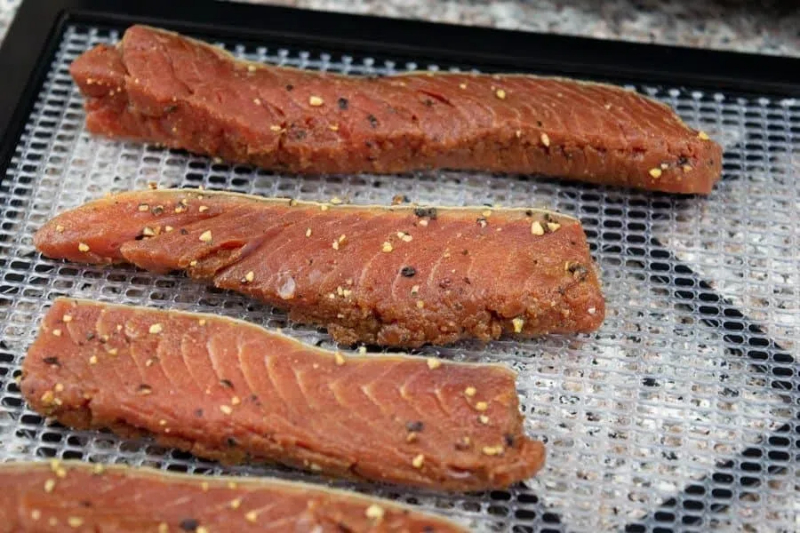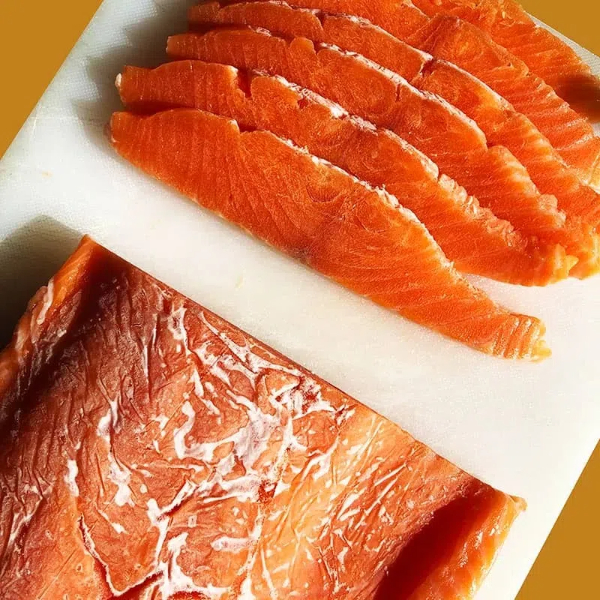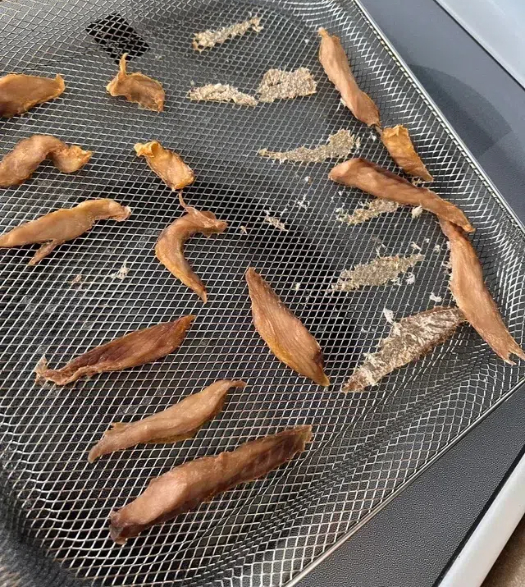
Content Menu
● Introduction to Dehydration Machines
>> Types of Dehydration Machines
● Preparation Steps for Dehydrating Salmon
>> Step 1: Cleaning and Slicing
>> Step 2: Marinating (Optional)
>> Step 3: Applying a Cure (Optional)
● Using the Dehydration Machine
>> Step 1: Setting Up the Dehydrator
>> Step 2: Dehydration Process
>> Step 3: Checking for Dryness
● Safety Considerations
>> Temperature Control
>> Storage
● Additional Tips for Dehydrating Salmon
>> Choosing the Right Salmon
>> Enhancing Flavor
>> Troubleshooting Common Issues
● Conclusion
● Frequently Asked Questions
>> 1. What is the ideal temperature for dehydrating salmon?
>> 2. How long does it take to dehydrate salmon?
>> 3. Do I need to marinate the salmon before dehydrating?
>> 4. Can I store dried salmon at room temperature?
>> 5. What type of dehydrator is best for dehydrating salmon?
● Citations:
Dehydrating salmon using a food dehydration machine is a popular method for preserving fish while maintaining its nutritional value and flavor. This process involves removing moisture from the salmon to prevent bacterial growth, making it safe for consumption over a longer period. Here's a comprehensive guide on how to use a dehydration machine for salmon, including preparation steps, dehydration techniques, and safety considerations.

Introduction to Dehydration Machines
Dehydration machines, also known as food dehydrators, are designed to remove moisture from food at controlled temperatures. These machines are ideal for preserving fruits, vegetables, meats, and fish like salmon. They come in various sizes, from small household models to large industrial units, making them suitable for both personal use and commercial production.
Types of Dehydration Machines
1. Household Dehydrators: These are compact and suitable for small batches of salmon. They are often used by individuals for personal consumption.
2. Commercial Dehydrators: Larger in size, these machines are used in food processing industries for mass production of dried salmon.
Preparation Steps for Dehydrating Salmon
Before dehydrating salmon, it's essential to prepare the fish properly to ensure the best results.
Step 1: Cleaning and Slicing
- Cleaning: Freshly caught salmon should be cleaned and gutted immediately.
- Slicing: Slice the salmon into thin strips, typically about 1 inch thick. This helps in even drying.
Step 2: Marinating (Optional)
Marinating can enhance the flavor of the salmon. Common marinades include soy sauce, brown sugar, black pepper, and liquid smoke.
Example Marinade Recipe:
- ½ cup soy sauce
- 2 tablespoons brown sugar
- ¼ teaspoon black pepper
- 1 teaspoon liquid smoke
Step 3: Applying a Cure (Optional)
For longer shelf life, a salt cure can be applied. However, this step is optional if you plan to store the dried salmon in the refrigerator or freezer.
Salt Cure Example:
- Use about 20% of the fish's weight in salt.
- Apply the salt evenly and let it sit for several hours or overnight.
- Rinse off excess salt before dehydration.

Using the Dehydration Machine
Once the salmon is prepared, it's time to use the dehydration machine.
Step 1: Setting Up the Dehydrator
- Place the salmon strips on the dehydrator trays, ensuring they do not overlap.
- Set the temperature according to the manufacturer's instructions. A common temperature for dehydrating salmon is around 145°F (63°C).
Step 2: Dehydration Process
- Dehydrate the salmon for 8 to 10 hours. The exact time may vary depending on the thickness of the slices and the humidity in your environment.
Step 3: Checking for Dryness
- After the dehydration cycle, check the salmon for dryness. It should be flexible but not soggy. If it feels too moist, continue dehydrating in shorter intervals until it reaches the desired dryness.
Safety Considerations
When dehydrating salmon, it's crucial to ensure that the fish is handled and stored safely to prevent spoilage and foodborne illness.
Temperature Control
- Ensure that the dehydrator reaches a temperature of at least 145°F (63°C) to kill bacteria.
- If your dehydrator does not reach this temperature, you may need to finish the drying process in a low-temperature oven (around 275°F or 135°C) for a short period.
Storage
- Store the dried salmon in airtight containers to maintain freshness.
- For longer shelf life, store in the refrigerator or freezer.
Additional Tips for Dehydrating Salmon
Choosing the Right Salmon
- Freshness: Use fresh salmon for the best flavor and texture.
- Fat Content: Salmon with higher fat content will be more tender after dehydration.
Enhancing Flavor
- Spices and Herbs: Add spices and herbs like garlic, paprika, or thyme to the marinade for extra flavor.
- Smoking: Use liquid smoke in the marinade to give the salmon a smoky flavor.
Troubleshooting Common Issues
- Over-drying: If the salmon becomes too brittle, it may be over-dried. Try adjusting the dehydration time.
- Under-drying: If the salmon remains too moist, continue dehydrating until it reaches the desired dryness.
Conclusion
Dehydrating salmon using a food dehydration machine is a straightforward process that requires careful preparation and attention to safety guidelines. By following these steps and tips, you can enjoy delicious and nutritious dried salmon at home or produce it commercially.

Frequently Asked Questions
1. What is the ideal temperature for dehydrating salmon?
The ideal temperature for dehydrating salmon is around 145°F (63°C). However, if your dehydrator does not reach this temperature, you may need to use an oven to complete the drying process.
2. How long does it take to dehydrate salmon?
Dehydrating salmon typically takes between 8 to 10 hours, depending on the thickness of the slices and environmental humidity.
3. Do I need to marinate the salmon before dehydrating?
Marinating is optional but recommended to enhance flavor. Common marinades include soy sauce, brown sugar, and liquid smoke.
4. Can I store dried salmon at room temperature?
Dried salmon can be stored at room temperature for a short period, but for longer shelf life, it's recommended to store it in the refrigerator or freezer.
5. What type of dehydrator is best for dehydrating salmon?
Both household and commercial dehydrators can be used for dehydrating salmon. The choice depends on the quantity you plan to produce.
Citations:
[1] https://www.homebrewtalk.com/threads/dehydrating-salmon.476589/
[2] https://www.lyhero.com/upload/file/202212/29_095051_5749.xlsx
[3] https://www.youtube.com/watch?v=zUlYT51Dzzk
[4] https://huggingface.co/facebook/xm_transformer_unity_en-hk/raw/main/en_zh_spm.dict
[5] https://www.ike.cn/fish-drying-machine.html
[6] https://blog.csdn.net/yaday/article/details/7535618
[7] https://www.reddit.com/r/dehydrating/comments/1cwro16/dehydrating_fish/
[8] https://www.cs.cmu.edu/afs/cs.cmu.edu/project/cmt-40/Nice/Transfer/Chinese/xferlexicon
[9] https://www.alibaba.com/showroom/fish-dehydrator.html











